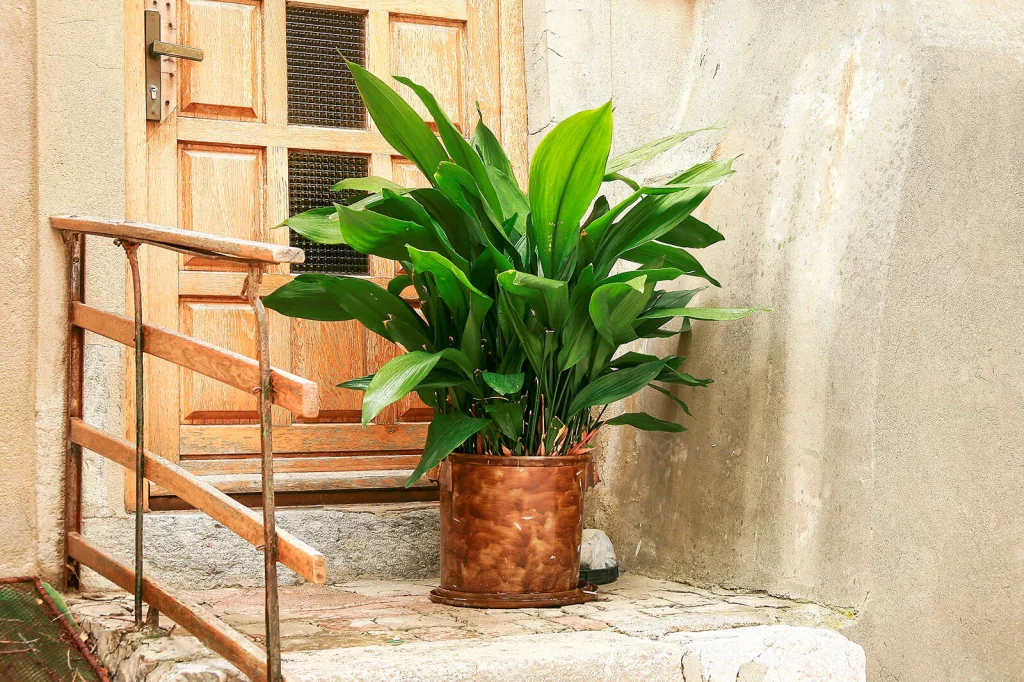
In the bustling streets of Fuencarral in Madrid, nestled near the Bilbao roundabout, amidst the perpetual semi-darkness of an odd-numbered sidewalk portal, reside two aspidistras. These botanical denizens have graced the building longer than any of its human occupants. Their caretaker, Manolo Cabezuelo, tends to them diligently. “They don’t demand much specific attention,” he assures. “Just regular soil, water when the substrate is dry, and occasionally, a bit of fertilizer for leafy plants. And of course, cleaning the leaves to remove pollution particles and dust,” he adds. “The building owner has known these aspidistras for a lifetime. She cares deeply about them, ensuring they are well-maintained,” he explains about the specimens adorning the portal, housed in two stone planters intricately carved with motifs resembling the plant itself.
Introduction to the Aspidistra
The Aspidistra elatior, commonly known as cast-iron plant or bar-room plant, originates from China and Japan, where it thrives in the shady recesses of jungles and forests. With slow growth, it propagates through rhizomes, producing large lance-shaped leaves in dark green hues. There are also variegated varieties, with white and cream stripes, and speckled types, dubbed ‘milky way’ or ‘Vía Láctea.’
The Resilience of the Aspidistra
The aspidistra stands as the Methuselah of indoor plants. Long-lived and incredibly resilient—colloquially termed the cast iron plant—it requires minimal care regarding temperature, watering, light, or humidity. It could be considered one of the most resilient plants, thriving in various climates and an ideal choice for novice plant caregivers or households with extended absences. Patios, porches, stairwells, hallways, vestibules, and any space away from direct sunlight and central heating are its preferred habitats. Sun rays scorch its leaves, causing brown spots and deteriorating the edges and contours, hence another popular moniker: parlor palm, alluding to its preference for indoor spaces and its carefree tolerance for darkness.
Personal Stories and Traditions
María Victoria Blanco, a resident of Arapiles, Madrid, for over 60 years, reminisces about the aspidistras adorning her building’s portal. “The aspidistra is tough, even tougher than pothos, which says a lot,” she remarks. “In my hometown, many houses had them in the vestibule, one on each side of the door. They hardly needed any attention; they didn’t mind winter or summer. Sometimes we’d go without watering them for a while, and they were fine with minimal light. I remember we’d clean their leaves with cotton soaked in oil, and they’d shine beautifully,” Blanco recalls. To propagate them, one simply needs to divide the clump when new shoots emerge.
Care and Maintenance Rituals
The cleanliness and luster of its leather-like leaves are crucial for the health and beauty of the aspidistra. “I clean them with beer. I buy a cheap brand, pour it into a spray bottle, and every 15 days, I spray the leaves and then polish them with a soft cotton cloth,” says Juani, the concierge of a residential block in Chamberí. Barley in beer is a source of minerals like magnesium, essential for plants to produce chlorophyll, which gives leaves their green color. It also contains potassium and phosphorus, which strengthen vital plant structures and keep them vigorous.
Historical Significance and Aesthetic Appeal
Apart from its ease of care, the aspidistra’s stunning foliage texture, dynamism, and presence contribute to its popularity. Much admired during the Victorian era, it caused a sensation in the United Kingdom during the 19th century as an ornament in affluent homes. Today, this lush plant with its decadent and wild beauty is the perfect choice for those enamored with the strelitzia or bird of paradise—so trendy in interior botanical décor—but lacking sufficient light for its cultivation in their living spaces.
The Aspidistra as a Companion
It’s fascinating to observe how the longevity of this plant fosters almost familial relationships. Instagram serves as a prime example (#aspidistra), showcasing people posing with their aspidistras, taking selfies with them, embracing them, and portraying them with such care that one might almost believe the plant possesses a sentient entity. It becomes a companion present through the years, in both good and bad times. Though its growth is slow, with an average production of five or six new leaves each year, a well-acclimatized aspidistra can easily live for over a century. Grandmothers, mothers, grandchildren… and always the same aspidistra. A steadfast relative surviving from generation to generation. Like a cherished heirloom carrying sentimental memories and shared experiences.
These stories and traditions surrounding the aspidistra not only highlight its remarkable resilience but also its role in human lives, weaving a narrative of endurance, care, and continuity through the ages. From its humble origins in the dense forests of East Asia to its ubiquitous presence in urban dwellings across the globe, the aspidistra stands as a testament to the enduring bond between humanity and nature.